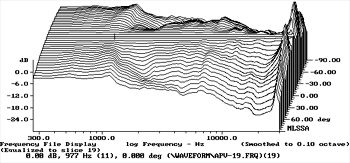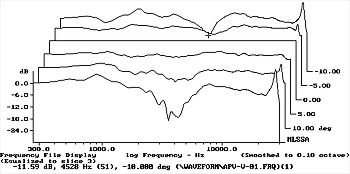| Columns Retired Columns & Blogs |
Audio Physic Virgo loudspeaker Measurements part 2
Regarding the Virgo's horizontal dispersion (fig.4, which shows just the changes in response off-axis), there's a peculiar step around 1kHz, which is perhaps due to the side-firing woofers. Other than that and a slight flare at the bottom of the tweeter's passband, the dispersion is even, with progressive HF rolloff as the listener moves to the speaker's sides. This always correlates with excellent imaging ability, and the Virgo is no exception, to judge from MF's auditioning comments and my own listening. The apparent peak at 27kHz in this graph is due to the on-axis interference notch in figs.2 and 3 filling-in, as expected, to the speaker's sides.

Fig.4 Audio Physic Virgo, horizontal response family at 50", normalized to response on tweeter axis, from back to front: differences in response 90 degrees-5 degrees off-axis; reference response; differences in response 5 degrees-90 degrees off-axis.
Vertically (fig.5), the Virgo's balance doesn't change significantly as long as the listener's ears are between 34" and 37" from the ground, which Tom Norton has found to be a typical listening height in normal domestic chairs and sofas. (Director's chairs tend to place a listener's ears between 40" and 43" from the floor.) Above or below that range, however, a suckout appears in the upper crossover region.

Fig.5 Audio Physic Virgo, vertical response family at 50", normalized to response on tweeter axis, from back to front: differences in response 10 degrees-5 degrees above tweeter axis; reference response; differences in response 5 degrees-15 degrees below tweeter axis.
- Log in or register to post comments




































